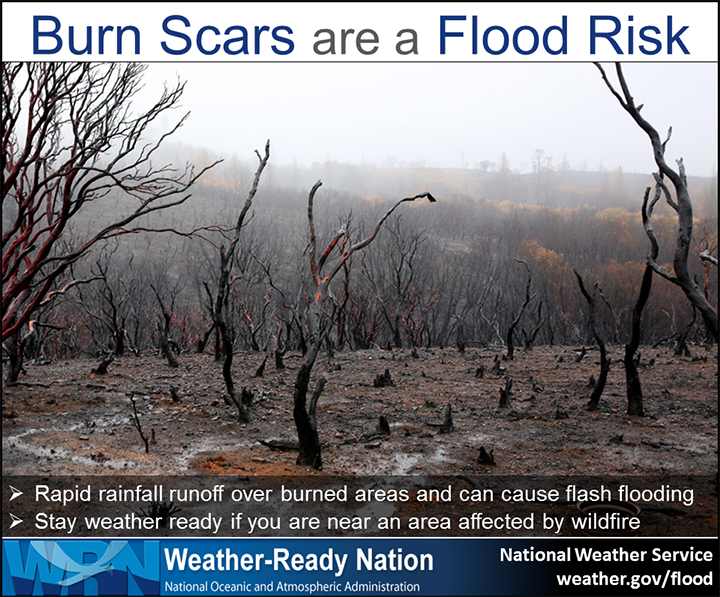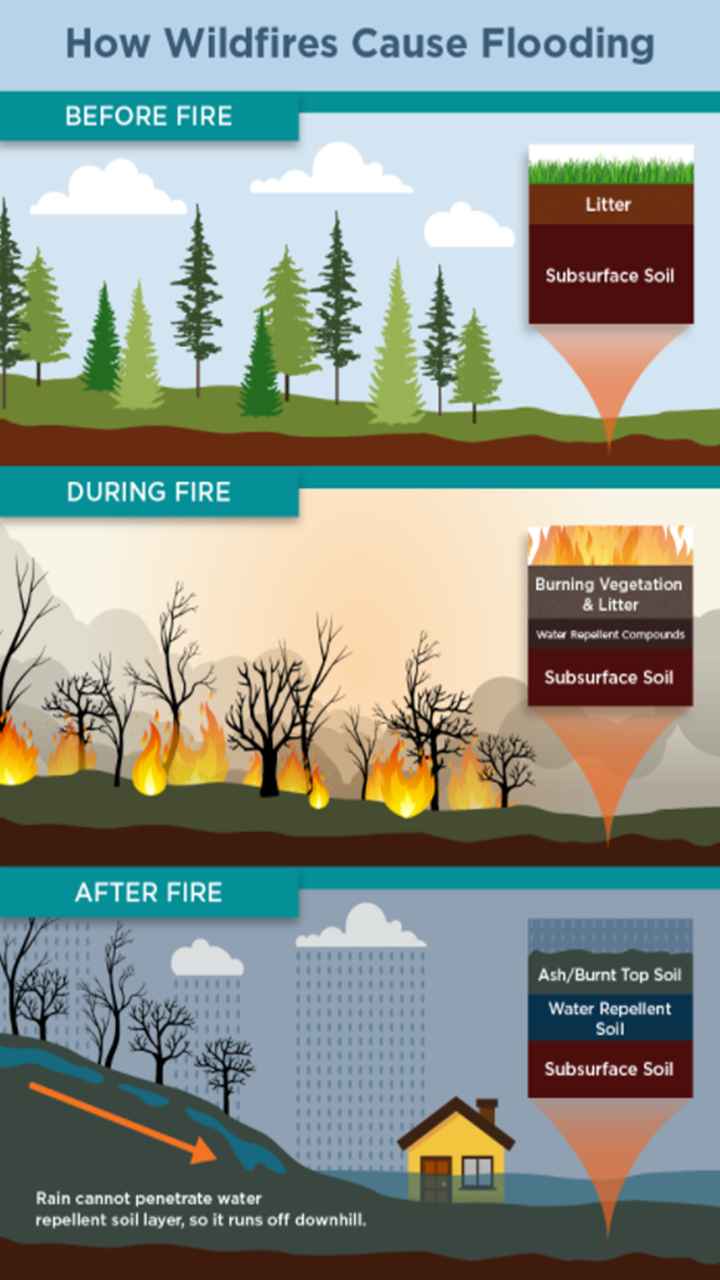Flood danger after wildfire
Flooding danger
Flooding after a fire
- Flash floods after wildfires can occur within minutes after the onset of a rainstorm.
- Even areas that are not traditionally flood-prone are at risk due to changes to the landscape caused by fire.
- Flood risk remains significant for up to five years after a wildfire.
- Residents need to protect their homes and assets with flood insurance now—before a weather event occurs and it’s too late.

Get flood insurance now
Only flood insurance covers flood damage.
- Most standard homeowner’s policies do not cover flood damage.
- It typically takes 30 days for a new flood insurance policy to go into effect, so get your policy now.
Learn more about the National Flood Insurance Program.
Visit the Flood Insurance website from Federal Emergency Management Agency (FEMA).
How flooding occurs
Debris flows often happen in areas where excessive rain causes soil to become so saturated it turns into very runny mud.
- The mud then races downhill, picking up debris such as
- ash
- fallen branches
- tree trunks
- rocks
- Debris flows can bury homes under piles of mud and debris.
Know the risks of the area where you live and prepare your family and home before heavy rains threaten your area.
Flood After Fire - FEMA Information
Did you know wildfires dramatically alter the terrain and increase the risk of floods? Excessive amounts of rainfall can happen throughout the year, and properties directly affected by fires and those located below or downstream of burn areas are most at risk for flooding.
- During normal conditions, vegetation helps absorb rainwater.
- But after an intense wildfire, burned vegetation and charred soil form a water repellent layer, blocking water absorption.
- During the next rainfall, water bounces off the soil. Higher degrees of land slope speed up water flow and increase flood risk.
- As a result, properties located below or downstream of the burn areas are at an increased risk for flooding.
Flash Floods: Intense rainfall can flood low-lying areas in less than six hours. Flash floods roll boulders, tear out trees, and destroy buildings and bridges.
Mudflows: Rivers of liquid and flowing mud are caused by a combination of brush loss and subsequent heavy rains. Rapid snowmelt can also trigger mudflows.
Resources
Learn more about the National Flood Insurance Program.
Visit the Flood Insurance website from Federal Emergency Management Agency (FEMA).
Flash Flood Safety and Preparation
Visit the Floods page on the Ready website.
Floods After Fires
Wildland Fire Management - Floods Follow Fires - FEMA Flyer (English Version)
Wildland Fire Management - Floods Follow Fires FEMA Flyer (Espanol Version)
Flood Watch versus Flood Warning
Flash Flood Warning: Take Action!
A Flash Flood Warning is issued when a flash flood is imminent or occurring.
• A flash flood is a sudden violent flood that can take minutes to hours to develop.
- It is possible to experience a flash flood in areas not immediately receiving rain.
- Move immediately to high ground if you are in a flood-prone area.
- A flash flood is a sudden violent flood that can take minutes to hours to develop.
- It is possible to experience a flash flood in areas not immediately receiving rain.
Flood Warning: Take action!
A Flood Warning is issued when a hazardous weather event is imminent or already happening.
Flood Watch: Be prepared
A Flood Watch is issued when conditions are favorable for a specific hazardous weather event. It does not mean flooding will occur, but it is possible.
Flood Advisory: Be aware
A Flood Advisory is issued when a specific weather event that is forecasted to occur may become a nuisance and cause significant inconvenience.
If caution is not exercised, it could lead to situations that may threaten life and property.
For more information
visit the Flood Safety Tips and Resources website from the National Weather Service.
Debris flow danger
A burn scar
In areas where wildfires have occurred
- Vegetation may have been burned away.
- Soil properties may have been altered.
- Leaving bare ground that tends to repel water.
When rain falls over a burn scar
- The ground is unable to absorb moisture.
- Water collects or runs across the ground's surfaced towards the lowest point.
- Without vegetation to hold the soil in place, flooding can produce mud and debris flows.
When normally dry soil becomes overly saturated
- It can reach a point where it turns to a liquid state.
- Flows downhill, becoming a river of mud.
-
Mud and debris flow can
- Destroy homes
- Wash out bridges and roadways
- Knock down trees
- Deposit large amounts of mud and other debris on previously clear surfaces.
- Damage or bury everything in their path.
Areas impacted by a wildfire
- Can be at a higher risk for mudflows
- Where the ground cover has recently changed dramatically can create a debris flow.

What is a debris flow?
Fast-moving, deadly landslides consisting of
- Loose mud
- Sand
- Soil
- Rock
- Water
- Air
What causes a debris flow?
Most common during heavy rain after wildfires. It does not need prolonged rain or a saturated slope.
Debris flow warning signs
- Rushing water and mud
- Unusual sounds like cracking, breaking, roaring, or a freight train.
